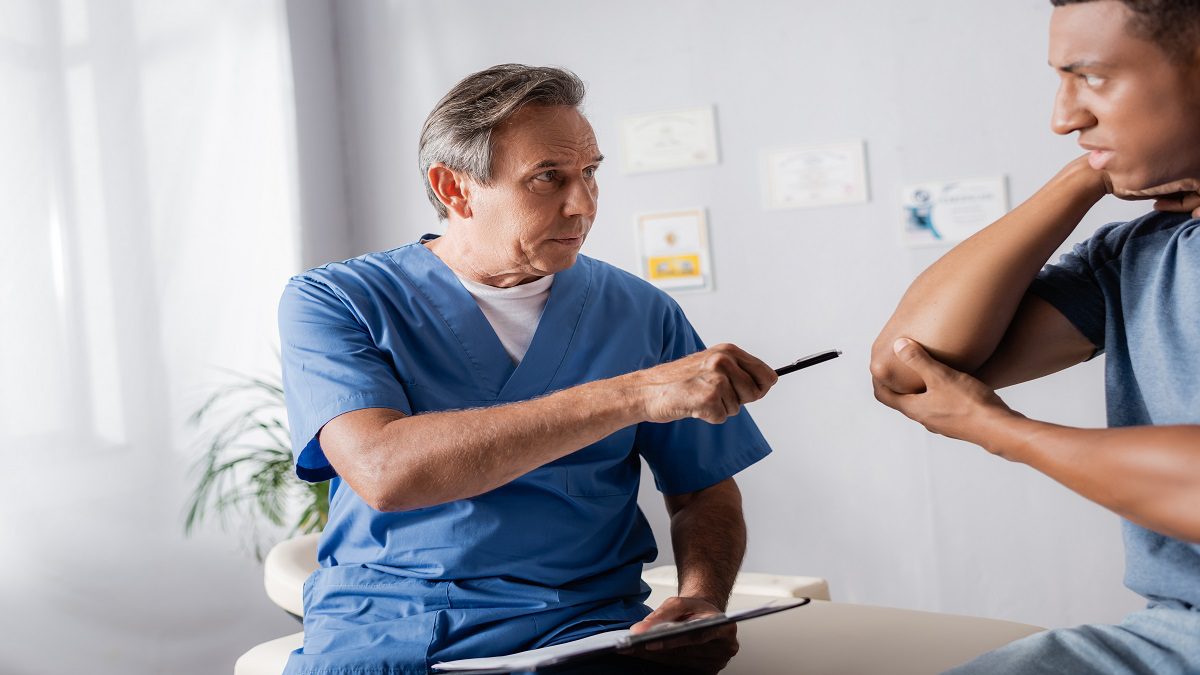Treatment of golfer’s elbow
Conservative treatment of golfer’s elbow
- ACTIVITY MODIFICATION: The first step in treating a golfer’s elbow is to avoid or at least reduce any activity that causes pain. This may mean playing less tennis or golf. However, the hand and arm should still be used within the limits of pain in most cases. This means, in general, that any activity that does not cause pain can be continued. While continuing to remain active when some pain is still present does not cause severe harm, the pain will only delay healing and needs to be avoided.
- COLD THERAPY: Cold applications are helpful for a golfer’s elbow (medial epicondylitis) because they can help relieve pain and reduce inflammation. Ice after the activity is beneficial, and in addition, two to three other times throughout the day are typically recommended. An ice pack for 20 to 30 minutes to the area or an ice massage for the same length of time will work equally as well.
- STRENGTHENING AND STRETCHING: Exercises to stretch and strengthen the involved tendons and muscles are essential in treating the golfer’s elbow. Gentle stretching typically begins with the wrist and elbow and is done with strengthening exercises. Physicians can show patients how to do these movements, or in more severe cases, physical therapy might be recommended.
- STRAPS: In some cases, the golfer’s elbow straps are helpful for medial epicondylitis. There are different types available, and these are worn one to two inches below the elbow. They are designed to reduce stress from the tendon at the point of attachment with the bone and are typically worn with activities. They are not meant to be the only golfer’s elbow treatment method. Instead, they are a supplement to strengthening and stretching.
- WRIST BRACES: These are worn for the golfer’s elbow to keep the wrist in a forward position. This reduces stress from the muscles at the point of attachment with the elbow. These are often used in cases of severe pain associated with medial epicondylitis, most often during sleep. However, sometimes they are used with activity as well.
- EXTRACORPOREAL SHOCK WAVE THERAPY: This golfer’s elbow treatment method sends sound waves to the inflamed area. These waves promote healing by creating “micro-trauma.” This therapy may be effective, but some doctors consider it to be experimental.
With appropriate treatment, most cases of medial epicondylitis that are not severe usually resolve within several weeks. In chronic or more severe cases, recovery can take up to six months. This is especially true if the condition has been present for an extended period. Early physical therapy can help shorten recovery time.
Golfer’s elbow medications
- NSAIDs (nonsteroidal anti-inflammatory drugs) can be very helpful in reducing the inflammation and pain of the golfer’s elbow. These include over-the-counter medicines like naproxen and ibuprofen. Typically, these medications for golfer’s elbow treatment are taken daily for up to six weeks in severe cases of medial epicondylitis. For less severe cases, these drugs can be used on an as-need basis. However, these medications have the risk of side effects, and patients should ask their physician before using them.
- CORTISONE SHOTS: When other treatments fail to provide relief from the golfer’s elbow, injections of corticosteroids might be considered. These injections are given directly in the area of inflammation to decrease swelling and pain. In some cases, these injections can cure medial epicondylitis, and in some cases, more than one cortisone injection is needed. After an injection, it is usually necessary to continue ice to the elbow area and also anti-inflammatory medications.
Surgical treatment of golfer’s elbow
If conservative therapy is not successful in controlling the pain of the condition, a golfer’s elbow surgery may be needed.
TENDON DEBRIDEMENT
When the golfer’s elbow is due to irritated tendons, the affected tissues might be removed. Only the damaged tissue is removed in this procedure.
TENDON RELEASE
This is a common procedure for a golfer’s elbow. It is sometimes called a medial epicondyle release. This procedure removes stress from the flexor tendon. An incision is made over the bony protrusion on the inner elbow. The tendon is cut at the point of attachment to the medial epicondyle, and any bone spurs are removed. Other structures, such as the nerves, are inspected to ensure no other complications are present, and the incision is surgically closed.
This surgery for the golfer’s elbow is usually done outpatient and does not require a hospital stay.
Source healthline
















Leave a Reply
You must be logged in to post a comment.